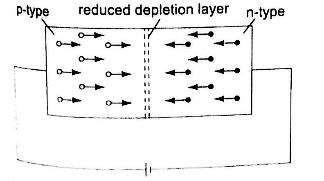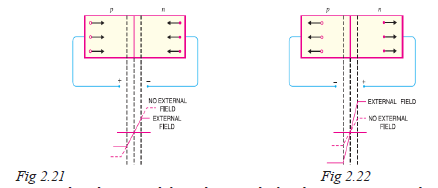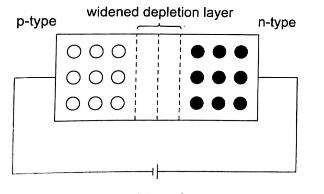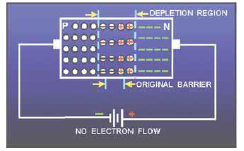1. Forward bias of a p-n junctionIt occurs when the p-type block is connected to the positive terminal and the n-type block is connected to the negative terminal of a battery. The depletion layer of the junction reduces to be very thin to allow the flow of electric current.

- When external d.c. voltage applied to the junction is in such a direction that it cancels the potential barrier, thus permitting current flow, it is called forward biasing.
- To apply forward bias, connect positive terminal of the battery to p-type and negative terminal to n-type as shown in Fig. 2.21. The applied forward potential establishes an electric field which acts against the field due to potential barrier. Therefore, the resultant field is weakened and the barrier height is reduced at the junction as shown in Fig. 2.21. As potential barrier voltage is very small (0.1 to 0.3 V), therefore, a small forward voltage is sufficient to completely eliminate the barrier.
- Once the potential barrier is eliminated by the forward voltage, junction resistance becomes almost zero and a low resistance path is established for the entire circuit. Therefore, current flows in the circuit. This is called forward current. With forward bias to pn junction, the following points are worth noting:
(i) The potential barrier is reduced and at some forward voltage (0.1 to 0.3 V), it is eliminated altogether.
(ii) The junction offers low resistance (called forward resistance, R
f) to current flow.
(iii)Current flows in the circuit due to the establishment of low resistance path. The magnitude of current depends upon the applied forward voltage.
 2. Reverse bias of a p-n junction
2. Reverse bias of a p-n junctionThe negative terminal of the battery is connected to the p-type region while the n-type is connected to positive terminal.
The depletion layer widens and resists the flow of electrons to minimal or zero (no currentflowing through) when the electric field increases beyond critical point the diode junction eventually breaks down and at this voltage it is referred to as the breakdown voltage. Diodes are intended to operate below the breakdown voltage.

- When the external d.c. voltage applied to the junction is in such a direction that potential barrier is increased, it is called reverse biasing.
- To apply reverse bias, connect negative terminal of the battery to p-type and positive terminal to n-type as shown in Fig. 2.22. It is clear that applied reverse voltage establishes an electric field which acts in the same direction as the field due to potential barrier. Therefore, the resultant field at the junction is strengthened and the barrier height is increased as shown in Fig. 2.22. The increased potential barrier prevents the flow of charge carriers across the junction. Thus, a high resistance path is established for the entire circuit and hence the current does not flow. With reverse bias to pn junction, the following points are worth noting:
(i) The potential barrier is increased.
(ii) The junction offers very high resistance (called reverse resistance, R
r) to current flow.
(iii) No current flows in the circuit due to the establishment of high resistance path.
 Conclusion:
Conclusion: From the above discussion, it follows that with reverse bias to the junction, a high resistance path is established and hence no current flow occurs. On the other hand, with forward bias to the junction, a low resistance path is set up and hence current flows in the circuit.
Mutiso answered the question on
October 18, 2018 at 18:07